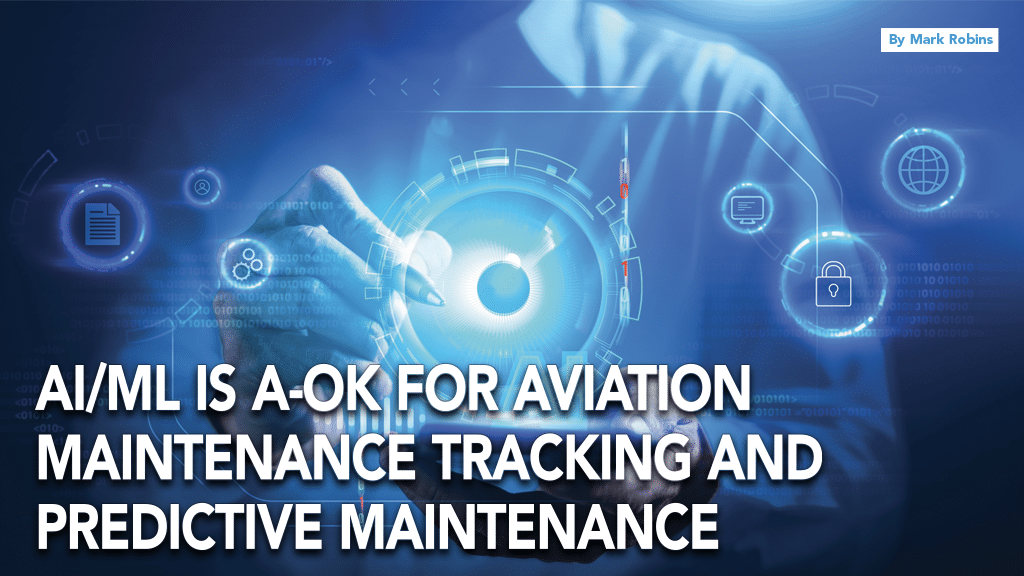AI/ML’s role in aviation maintenance software systems for maintenance tracking and predictive maintenance offers enhanced safety, cost savings, real-time insights and tailored maintenance strategies
According to Ottawa, Ontario, Canada-based research firm Precedence Research, the global artificial intelligence (AI) in aviation market size was estimated at $653.74 million in 2021 and it is expected to surpass $9 billion by 2030 with a registered CAGR of 35.38% from 2022 to 2030. This “super-smart” aviation software is changing operations and shaping the industry’s future, in addition to modernizing operations.
Artificial intelligence and machine learning (ML, a subset of AI) improves aviation services and smooths operations like maintenance tracking and predictive maintenance. An AI-powered system can inspect an aircraft for signs of wear and tear, such as cracks or corrosion, and then generate a report and schedule for necessary repairs. Generative AI can analyze data from sensors and other sources, comparing it to historical data to predict potential failures and optimize maintenance schedules. Because of its machine-learning algorithms, which can suggest optimal maintenance actions, such as repair, replacement, or adjustment, expensive delays can be minimized and passenger safety is guaranteed.

With real-time monitoring, Nicolas Decroix, product manager at Swiss Aviation Software, Basel, Switzerland, agrees that AI-powered systems can indeed continuously monitor the performance of various aircraft components, identifying deviations from normal operating parameters. With anomaly detection, “Machine-learning algorithms detect abnormal behavior or performance trends, alerting maintenance crews to potential issues before they escalate. [Also,] these technologies revolutionize traditional practices by providing data-driven, proactive and automated solutions. For maintenance scheduling and documentation, AI optimizes schedules based on historical data, reducing downtime and errors in documentation through automated logging.”
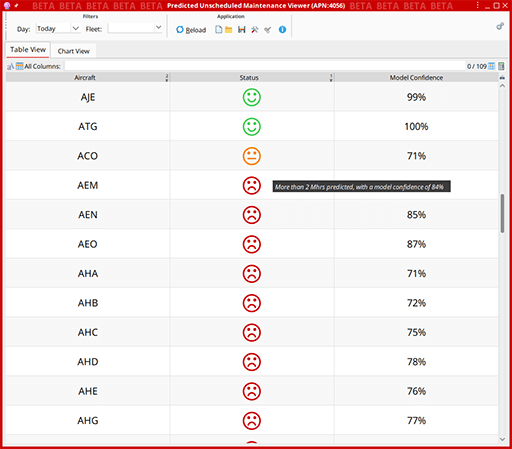
AI is really getting recognized for its ability to bring another level of aviation maintenance prediction. At the recent 2023 National Business Aviation Association’s NBAA Business Aviation Convention & Exhibition (NBAA-BACE) in Las Vegas, Elza Brunelle-Yeung, senior director, aftermarket products, digital and pricing, at Montreal, Canada-based Bombardier says, “AI can help analyze big data and predict when a part will fail. No human can really analyze that volume of data and that’s where AI comes in.” What follows is how that is being accomplished.

Maintenance Schedules, Documentation
AI can play multiple roles via constructing efficient and robust maintenance schedules. AI-powered MRO software can detect patterns and anomalies by analyzing performance data from various sources. “MROs also track supply chain issues and inventory to ensure aircraft parts are available when needed, significantly improving efficiency and reducing downtime for aircraft,” says Atal Bansal, founder and CEO of Bansi Aviation, Sunrise, Fla.

The power of AI/ML comes when large datasets are aggregated to derive patterns and behaviors. Hundreds and thousands of theoretical models can be combined to define a logic with the lowest absolute error. “AI/ML algorithms can analyze historical maintenance data to optimize scheduling for routine checks and repairs,” says Monica Badra, MRO expert and founder of Aero NextGen Inc., Montreal, Canada. “This predictive scheduling helps prevent maintenance overruns and reduce aircraft downtime. In the case of documentation, AI/ML models can write and automate the generation and retrieval of faults found, symptoms and corrective actions in the teardown report, before the technician even performs the repair due to commonalities in historical data. The models can decipher what condition the part must be repaired to (test, repair, overhaul) based on the cycle times, repair history contained in the MRO’s data infrastructure and the customer’s repair order. Instead of prescribing these data points, the technician will be in a position to validate and edit the model’s outputs after the completion of the inspection, reducing administrative burden exponentially, and increasing component touch-time, ultimately making MROs more efficient.”

Simon Miles, head of AI, Aerogility, London, U.K., says AI offers two primary predictive maintenance features: prediction from patterns in data and reasoning over complex constraints. “Machine-learning-driven prediction allows the inputs to scheduling to be more accurate than OEM guidance or simple averages, for example, with turnaround times or likely costs. By itself, prediction doesn’t meet the challenge of constructing optimized schedules that fit maintenance into the capacity constraints of the coming months and years and optimize against key KPIs, such as cost. For this, interactive reasoning using model-based AI is valuable, automatically planning and replanning from encoded knowledge of an organization’s specific constraints and allowing what-if analyses to ensure robustness to anticipated future issues.”
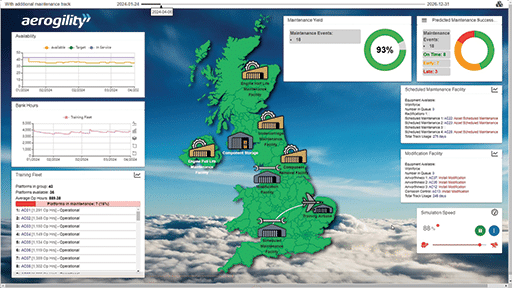
Artificial intelligence and machine learning take Miami-based Trax customers’ maintenance planning to the next level by offering advanced predictive insights. Analyzing historical data and external factors, ML foresees trends and outcomes, providing a foundation for informed decisions and intelligent MRO forecasting. This empowers prompt responses to shifting conditions, and gives the ability to adapt strategies and allocate resources optimally.
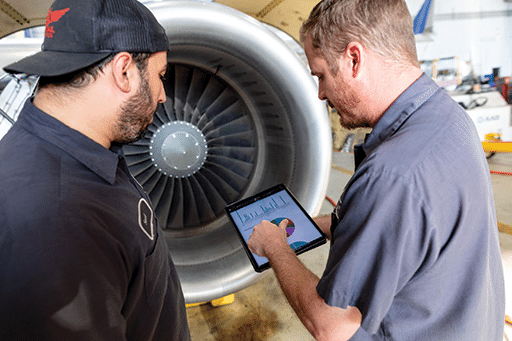
Most planning solutions utilize a fixed schedule for checks and maintenance due dates. But Justin Daugherty, senior director of sales and marketing at Trax says the Trax eMRO solution incorporates real-time data and advanced analytics to anticipate and optimize maintenance requirements. “The full system integration with all relevant modules (including web applications and iOS mobile apps) results in planning queries that considers variable factors like available manpower, site capacity, and availability of spares and tools. By analyzing real-time and historical maintenance data and usage patterns, the eMRO software can foresee a customer’s maintenance needs before they arise, allowing for proactive planning and reduced downtime. Since in aviation maintenance the unexpected is always to be expected, this data-driven capability — which manages variables — ensures our maintenance customers experience minimal disruption, reduced costs, and higher aircraft utilization.”

Mechanical Failure Prediction
In order to understand when a component onboard an aircraft will fail, Bobby Anderson, VP/GM, Aviation at Shift5, Rosslyn, Va., asserts that operators today too often rely on incomplete datasets to make maintenance decisions. “Mechanical failure predictions are informed by data from tools that take guesswork out of maintenance, but that don’t capture all data from all on board components. Machine learning is the lynchpin to making mechanical failure predictions possible. And, when we talk about what makes ML most powerful and accurate, it’s the data that’s fed into the model. Simply put, the more and better the data fed into ML models, the more precise the outcomes will be.”

Each onboard component and data bus on an aircraft generates its own set of data, at a consistently high volume, during a flight. For predictive maintenance to be effective, airlines need observability that includes data from the entire spectrum of onboard components, not just a selected few or at intervals that can’t provide a sufficient context of system operations. “Once maintainers and operators have observability from a complete and enriched dataset and apply ML to that data set, they can use it to understand the historical baseline of optimal system performance and identify anomalies that may signal a compromise from operational issue or a cybersecurity threat,” Anderson adds.
Maintenance-data Analysis
AI/ML’s ability to analyze massive datasets matches aviation maintenance needs because aircraft generate huge amounts of information like speed, altitude, fuel consumption, historical maintenance data, flight paths, engine parameters, manuals and much more. As aircraft become more technologically advanced and fleet sizes grow, the data generated by the components and data buses on board aircraft grow by orders of magnitude. For example, a Boeing 787 produces 0.5 terabytes of data per flight. That volume, paired with data flowing from other onboard avionics, can be fed into a solution designed to automate collection, analysis, and reporting.
“AI-driven aviation maintenance programs can evaluate all this data in real or near-real time,” Bansal says. “When trained on high-quality data, AI programs can find equipment operation anomalies and alert pilots and ground crews of potential problems.”
By analyzing large datasets, AI can uncover trends, predict part life cycles and recommend inventory stock levels. Not only streamlining maintenance tasks but also optimizing the supply chain. “There has been a huge transition toward digital solutions to proactively manage and forecast repairs on life-limited parts,” Badra says. “The development of predictive and preventative maintenance aggregates historical and real-time data, enabling just-in-time parts replenishment and manpower capacity planning for MROs. Also, predicting the condition of the part, based on historical behaviors driving efficiencies for MROs, as well as helping airlines provision for timely removals, reducing parked aircraft intervals and maintenance costs.”
Anderson contends, “Sifting through that kind of dataset to identify normal component performance and anomalous performance that could indicate failure — or impending failure — simply isn’t possible manually. However, many operators lack access to the complete set data generated by the onboard components and serial buses on aircraft, leaving them with an incomplete dataset to feed into machine-learning tools. Predictive maintenance is only truly predictive when maintainers have complete observability into aircraft — the ability to derive real-time, context-rich insights from refined onboard data. This enables operators with a more comprehensive understanding of their maintenance standing and needs, and also enables them to make smarter, faster decisions and actions. Simply put, access to onboard data in real time can provide operators and maintainers with a depth and completeness of insights about performance health that can assist in predicting and scheduling maintenance effectively.”
Trax has incorporated predictive analytics into its maintenance software. “Predictive maintenance enables airlines to plan maintenance schedules more accurately, minimizing downtime and reducing costs associated with unscheduled repairs,” Daugherty says. “Furthermore, AI-driven analytics can optimize the inventory management process, ensuring that airlines have the necessary parts and equipment available when needed. This level of efficiency not only saves resources but also ensures that aircraft are ready for service, thereby increasing overall operational performance.”
Rising Maintenance Costs
Rising maintenance costs are a significant concern for major airlines. In 2022, American Airlines, United, and Delta reported substantial increases in maintenance spending, with American Airlines spending $2.68 billion, a 35.6% increase from the previous year; United dedicating $2.15 billion, a 20% increase; and Delta reporting $1.98 billion, up from $1.40 billion in 2021.
AI/ML can help lower these costs. “Powered by AI and ML, predictive maintenance technology allows airlines to identify maintenance needs in real time, and locate potential failures before they happen,” Anderson says. [AI’s observability] allows leaders, pilots and maintainers to make informed decisions that can help ensure safety, protect valuable assets, reduce costs, and increase on-time flights. Getting ahead of failures can help reduce unscheduled downtime and work order cycle times, lowering costs, reducing delays and cancelations, and improving customer satisfaction. Done correctly, predictive maintenance can be a boon to airlines; commercial air leaders expect predictive maintenance to lower maintenance costs by 22%. However, less than half of airlines are benefitting or leading the charge when it comes to predictive maintenance deployments.”
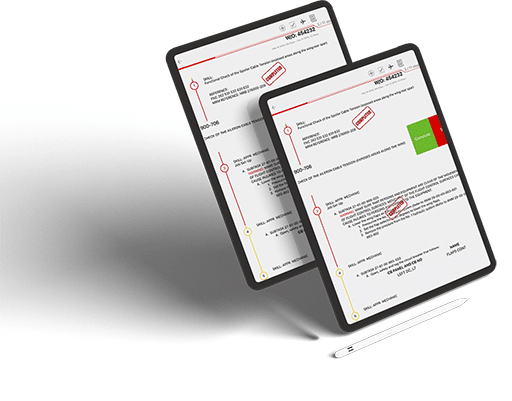
A Learning Curve
Just like other software programs, there will be a learning AI/ML curve. However, software developers understand that the programs must have intuitive interfaces so that many people can learn how to use the programs. Bansal explains that steeper learning curves may be required for highly specialized AI tools. “These programs are designed for ground-crew aircraft maintenance workers, not just data scientists or developers. The more advanced programs can be highly automated, while others require customization and manual adjustments. Data collection, which will always be ongoing, may be the most important part of setting up and maintaining a reliable AI platform. This task could be quite an undertaking, but if the data is reliable and bias- free, and the program is properly integrated into your existing systems, it can promote higher reliability of the output.”
Daugherty says Trax believes the industry has just begun to tap into the AI and ML possibilities. “While AI and ML technology is relatively easy to learn and apply, we also believe that knowledge of aviation maintenance processes, terminology, datasets, and regulations is crucial for effectively applying these techniques in the aviation context. Ensuring compliance with safety standards and regulations adds complexity to the development and deployment process.”
Bridging a Gap
Miles explains an interesting consideration of AI in aviation maintenance is how it may help bridge the understanding of maintenance needs and constraints between otherwise disparate departments of large organizations. “AI technologies of diverse kinds are helpful in managing a complexity of data and knowledge in augmenting both long-term strategic and immediate tactical decisions. This means that well-engineered AI software should be able to accommodate more and larger varieties of perspectives because it can model and reason things not just in isolation. For example, planning to maximize aircraft availability or maintenance yield, but including factors relevant to a variety of viewpoints, such as supply chains, budgeting constraints, staff availability and management. Ultimately, AI-driven software should provide an enterprise digital twin allowing diverse stakeholders to see different views on the same virtual model and make strategic decisions that are complementary and well-coordinated.”

Decroix believes AI/ML’s role in aviation maintenance software systems for maintenance tracking and predictive maintenance is transformative, offering enhanced safety, cost savings, real-time insights, and tailored maintenance strategies. “As these technologies continue to evolve, they represent a fundamental shift towards proactive, data-driven maintenance practices that are shaping the future of aviation maintenance and ensuring safer skies for all.”

Who’s Afraid of AI/ML?
There’s some fear around using AI/ML in maintenance tracking and inspection processes, according to Nicole Tibbetts, chief engineer for MRO at GE Aerospace, Cincinnati. “In response to those concerns, we’re sponsoring an industry advisory board to make recommendations about how you provide safeguards to ensure AI, automation and new robotics solutions are applied responsibly in ways that don’t enhance but rather reduce risks,” Tibbetts said. “Equally important is the overall strategy and approach for how you integrate AI into your maintenance and inspection processes. At GE Aerospace, we have a service engineer centric viewpoint when it comes to MRO. For us, the focus is on how technologies like AI, robotics and automation can enhance the quality and productivity of our service engineers. The Advanced Blade Inspection Tool (BIT) we deployed is a great example of this approach, where the AI is complementing and providing new insights for the service engineer to utilize beyond what they’re already doing to enhance inspections.”

As the aerospace industry heads into a decade of unprecedented growth, Tibbetts stresses, “It’s critically important that we support the growing installed base globally with technology advancements which allow additional maintenance providers to readily scale and accelerate the training of the next generation of aircraft maintenance engineers with safety and quality at the forefront. AI and machine learning can play a crucial role in the repair and overhaul industry, when governed appropriately and drive consistency across intrinsically variable inspection modalities where human judgement can be augmented with advanced image analytics to drive insights into a single maintenance event captured across a full fleet’s worth of data.”
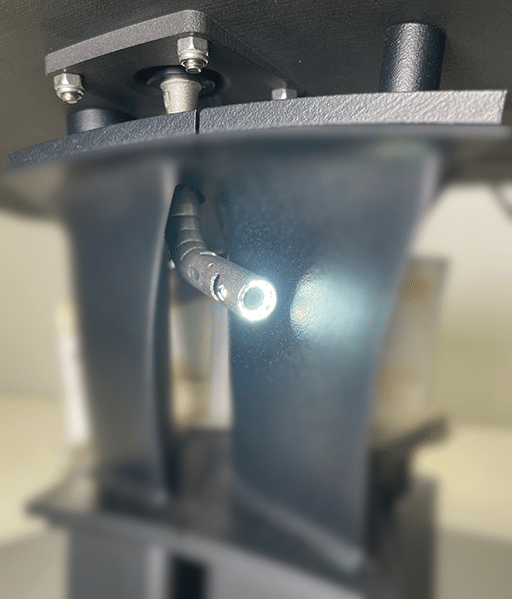
This is the AI-enabled Advanced Blade Inspection Tool (BIT) that GE Aerospace is using for the GEnx Engine as part of an on-wing inspection kit. The company says it is enabling faster, more accurate inspection assessments for GEnx engines with this AI technology. They are also developing a similar BIT using AI that is specifically tailored to support on-wing inspections for the CFM LEAP engine, manufactured through their 50/50 JV with Safran and CFM International, as well. GE Aerospace image.
